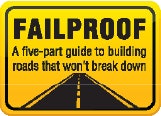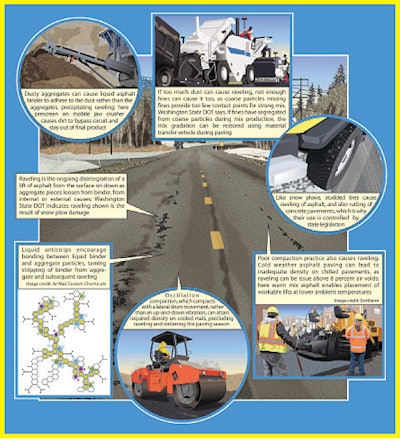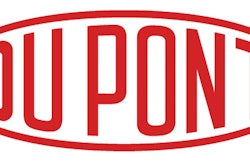
By Tom Kuennen, Contributing Editor
Raveling describes the loss of aggregate from the driving surface of a bituminous concrete pavement. Loss of aggregate through raveling encourages pothole formation and cracking, which can introduce water into a pavement structure. Thus raveling can endanger a pavement’s long-term performance.
Raveling also puts motorist safety at risk, which makes it a public safety problem as well. As raveled areas collect rain or melt water, they pose hydroplaning risks not unlike those shallow surface “bird baths” that plague asphalt paving crews.
The raveled area can degenerate into a pothole, which can damage tires, wheels, worsen pavement conditions and even cause accidents. Broken windshields, rough rides, and loss of stopping power in loose aggregate are fodder for road user complaints.


Raveling is not limited to HMA pavements. Chip seals can ravel too. “The most common distresses in chip seals are flushing or bleeding, and aggregate loss from the top layer, i.e., raveling,” say Raquel Moraes and Hussain Bahia, Department of Civil and Environmental Engineering, University of Wisconsin-Madison, in their 2013 Transportation Research Board paper, Effects of Curing and Oxidative Aging on Raveling in Emulsion Chip Seals. “Raveling is not restricted to the early life of the chip seal, and may continue to occur throughout the service life.”
 Raveling describes the loss of aggregate from the driving surface of a bituminous concrete pavement.
Raveling describes the loss of aggregate from the driving surface of a bituminous concrete pavement.Testing results showed that the rate of in-service raveling is dependent on the curing process and subsequent in-service oxidative aging as the adhesive and cohesive forces at the emulsion-aggregate interface change, they write. “The initial bond maturation results in a decreased rate of chip loss, while the in-service oxidative aging of the asphalt emulsion leads to a higher aggregate loss as a result of the emulsion’s strain intolerance and inability to relax stresses induced by traffic.”
Causes of Raveling
Raveling begins at the light stage, in which surface fines are lost. This can segue into moderate raveling, in which fines are lost and larger aggregate is exposed. Severe raveling describes the loss of both fine and coarse aggregate.
 Loss of aggregate through raveling encourages pothole formation and cracking.
Loss of aggregate through raveling encourages pothole formation and cracking.While there are different degrees of raveling, except for raveling caused by external damage, most raveling can be traced to moisture issues in mix design, or errors in compaction of the lifts. Whatever the initial condition, raveling usually is moisture-induced.
Stripping describes the loss of the adhesive bond between asphalt and aggregate. When the adhesive bond between asphalt and aggregate is broken, usually in the presence of moisture, stripping ensues and raveling may begin.
Stripping of asphalt binder from aggregate typically begins at the bottom of the HMA layer and progresses upward. But when stripping starts at the surface and progresses downward it results in raveling. Stripping can be tough to identify because its clues take different forms: rutting, shoving, corrugations, cracking or raveling. The only accurate way to determine if stripping is the cause of the observed distress is to core the pavement and examine the pavement structure cross-section.
This moisture damage can come from an inadequate pavement drainage system; a mix with excessive air voids due to inadequate compaction and low asphalt content; a mix where the aggregate surface is incompatible with asphalt binder and the binder is displaced by water; excessive pore pressure caused by traffic; and even the spontaneous emulsification of binder by water, says the Federal Highway Administration.
While much is being said about warm mix asphalt or cold bituminous mixes, the bulk of asphaltic concrete being placed still is conventional hot mix asphalt. There, to forestall raveling, mix temperature should be at a minimum of 290 degrees F in the middle of the mat behind the screed, says Granite Construction’s Todd Munson.
“The ideal mix temperature will vary slightly depending on the binder type used in the mix design, lift thickness, the time available for compaction, and ambient conditions,” he says. “The most efficient breakdown rolling should always occur at temperatures above 290 degrees F. When breakdown rolling begins at temperatures lower than 290 degrees F, the risk of not achieving sufficient compaction is greatly increased.”
 HMA mats will cool quickly in cold or wet ambient conditions, making getting density near impossible, which can lead to raveling; but oscillation compaction can achieve density on cooled mats.
HMA mats will cool quickly in cold or wet ambient conditions, making getting density near impossible, which can lead to raveling; but oscillation compaction can achieve density on cooled mats.Lift thickness plays a critical role in preventing raveling, as it relates to compaction, Munson says. “A minimum lift thickness of two times the maximum aggregate size should always be maintained. This allows enough room for particle reorientation and proper compaction to occur. If lifts are thinner than twice the maximum aggregate size, there is insufficient room for the aggregate to reorient itself in a dense configuration that is impermeable to water.”
Also, if the lift thickness is less than 2:1, aggregate fracture often occurs in the rolling process, leaving uncoated aggregate surfaces in the mix that will not bond, he says.
Placement of asphalt pavement in wet weather introduces water into the mix, promoting raveling. There, moisture may lodge on the coated aggregate particles, precluding a strong bond. If a mix is too cool to drive off moisture it encounters, risk of raveling is enhanced. If pavements are placed in wet weather, they also may cool more quickly, which can lead to undercompacted mats if they stiffen beyond workability, also putting the pavement at risk for raveling.
Compacting Cooled Mats
A new compaction technology has shown to be of value in compacting cooled mats. Oscillation compaction, which compacts with a lateral drum movement, rather than an up-and-down vibration, can attain required density on cooled mats, users say, precluding raveling and widening the paving season.
In the oscillation drum, two eccentric masses turning in the same direction cause a movement around the drum axle. The movement changes its direction of effect during one turn so it generates an oscillating or rocking movement of the drum. Horizontal forces are transmitted from the drum into the pavement. The result can be compaction in fewer passes, with less vibration-related wear and tear on operators and surroundings.
“Washington State has a spec that you cannot vibrate your mix below 175 degrees F,” says Cliff Schroeder, president and general manager, Watson Asphalt Paving, Redmond, Wash., in a 2009 interview. “They feel it will be too cold, the liquid too brittle, and that the bond between the oil and rock will be broken.”
Static rolling of cooler mixes is permitted, Schroeder says, but with the ambient temperatures often encountered, that 175 degrees F point can be reached rather quickly. “At that point, there will not be enough energy left in the mat to permit the mat to be compacted, pushing the air out of it. You could be in trouble with a deduction on the mix for failure to compact.” But oscillation will get density on those cooled mats, he says.
Watson owns two oscillation rollers, a Hamm HD+ 120 VO, and an older HD O90V. Schroeder was able to actually see and compare the movement of aggregate particles by vibration and oscillation.
“In our yard we have a ramp where a loader dumps excess stockpile material,” Schroeder says. “It’s unconsolidated, so to test performance we ran a vibratory roller up it, followed by an oscillation roller. I physically could see the metrics change in the way the aggregate was assembled together. Vibratory by itself just drives the particles straight down, leaving them not touching; but oscillation consolidates them and locks them down tighter.”
On a fall parking lot reconstruction over a poorly constructed base, saturated after heavy rain, as many as six passes with a vibratory roller failed to get density, the contractor says. “They were hitting it hard, but still not getting it,” Schroeder says. “It was bringing water straight up into the mat, chilling it. I told them to go static and oscillation only. The result was a string of 93s and no water. Oscillation is yet another tool for us to use to meet our client’s needs.”
Aggregate Segregation and Raveling
Aggregate segregation of an asphalt mix prior to placement often causes raveling, experts say. Segregation can occur in the plant prior to load-out, in the haul truck on the way to the job, and when mix is dumped by truck into the receiving hopper of the asphalt paver.
Why is this a problem? If fines aren’t present in locations within the asphalt mix, then the liquid asphalt binder will bind the coarse particles at their relatively few contact points, says the Washington State Department of Transportation. These weak bonds may break under loads and raveling will begin.
Hot mix plant storage silos, truck loading and unloading methods, and placement of HMA into the paver all are trouble spots for segregation.
A segregated mix results in an excess of inter-connected void space. There will be insufficient contact area between the asphalt binder-coated aggregate particles to form a strong bond, and the asphalt lift will be somewhat permeable, permitting the action of tires to force water through the pavement as they physically disturb the aggregate, forcing rutting and weathering.
Mixes can segregate during hauls. If fines have segregated from coarse particles during mix production or transport, the mix gradation can be restored using material transfer vehicles during paving. The use of the MTV – in the United States, the Astec Shuttle Buggy – is required by many state DOTs, and contractors will use them anyway because they enhance smoothness by isolating the paver from bumps caused by the haul truck.
Polymer Modifiers Quell Raveling
Despite their lack of fines, open graded friction courses (OGFCs) – like those used in the southern tier of states to suppress tire spray in rain events – successfully resist raveling when polymer modifiers are used in the binder, say Yetkin Yildirim, Terry Dossey, Ken Fults and Manuel Trevino, Center for Transportation Research, University of Texas at Austin, in their report, Winter Maintenance Issues Associated with New Generation Open-Graded Friction Courses.
The early OGFC mixes had problems in terms of lack of durability and concerns with winter performance and maintenance issues, which caused discontinued use of the mixes. “Research on the first generation OGFCs has shown that raveling can occur in a short time, in as little as six to eight years,” they say. “However, with changes in open-graded mixture technology … there has been increased interest in the use of New Generation Open-Graded Friction Courses (NGOGFCs), or Porous Friction Courses (PFCs).”
These second-generation OGFCs are more open-graded, have increased air void structures at a minimum of 18 percent (as opposed to the first generation OGFCs, which had air void structures between 10 percent and 15 percent), utilize more asphalt, and are enhanced with polymer asphalt, rubber asphalt, and fiber additives, they report.
The design of PFCs has reduced some of the durability problems associated with the first-generation OGFCs, they say. “First, using modified asphalt counters the tendency of PFCs to ravel by keeping the aggregate pieces together better,” they write. “Second, more asphalt is used and placed 1.5 to 2.0 inch thicker, providing thicker films that resist aging and allow water to drain more quickly. Third, the open texture of PFCs allows water to be flushed out by high-speed traffic, therefore reducing the potential to get clogged over time.”
Research in the 1990s at the National Center for Asphalt Technology (NCAT) showed that states using polymer modified binders for porous friction courses had fewer problems such as raveling, debonding, stripping of underlying layers, and scrapes by snowplows.
Stripping is sometimes indicated by the presence of raveling, popping out of aggregate or flushed areas on the surface of the OGFC pavement, accompanied by shoving or roughness in the wheel path, they say. Techniques to evaluate stripping include coring the area, visual inspection, and measurement. “One respondent noted that his district has not experienced stripping since using crumb rubber,” they say.
OGFC technology continues to evolve. New research indicates heavier tack coats will suppress raveling of OGFCs, say Nam Tran, Buzz Powell, P.E., and Richard Willis, National Center for Asphalt Technology, David Timm, P.E., Auburn University, and Gregory Sholar, P.E., Florida DOT, in their 2013 TRB paper, Effectiveness of Heavier Tack Coat on Field Performance of Open-Graded Friction Course.
“Compared to a conventional hot mix asphalt mixture, [an] open-graded friction course is more prone to pavement distresses such as cracking and raveling, resulting in a shorter service life,” they say. “One way to potentially improve the performance of OGFC is to enhance the interface bond between the OGFC and the underlying layer by applying a heavier tack coat … [T]he results of this study showed that the OGFC layer in Section N1 in which a heavier tack coat was applied performed better than that of Section N2 in which a conventional tack coat was used. Heavier tack coats are recommended to improve the performance of OGFC surfaces.”
No Dirt or Dust: Cleanliness is Extremely Critical
Just as a lack of fines can precipitate raveling, dirt or dust in the aggregate can cause raveling, Granite Rock’s Munson says.
“The cleanliness of the aggregate is very critical in mitigating raveling. Dirty aggregates coated with dust or fines create a barrier to direct contact (bonding) between the asphalt cement and the aggregate.
“The weakest portion of the resulting aggregate-dust-asphalt bond is the aggregate-dust adhesion.
“After several repetitions of the physical forces of traffic loading, the forces of adhesion holding the dust to the aggregate will break, and dislodging of the aggregate from the pavement mass will occur.”
An excess amount of dust or fines also has the potential to absorb a high percentage of asphalt cement, lowering the effective asphalt content of the mix, leading to binder content problems outlined earlier, Munson adds.
Pavement distresses related to moisture damage improve with the use of anti-stripping additives. Antistrip additives promote adhesion between the mineral aggregate and the asphalt in hot mix asphalt mixtures. They can be as complex as manufactured chemicals or as simple as lime.
Antistrips work, but their higher cost must be balanced against lower maintenance expenditures over time.
In Wisconsin, moisture damage in HMA pavements – specifically raveling, stripping, rutting and alligator cracking – occurs occasionally as it does nationwide, and tests of a mixture’s potential to suffer such damage is a standard element of highway construction specifications, the state reported.
In the early 1990s, the Wisconsin DOT adopted the Tensile Strength Ratio test, using the ASTM D4867 standard method, to predict mix susceptibility to moisture damage.
WisDOT required that antistrip agents be added when the TSR of a mixture at optimal asphalt content fell below 70 percent. The enhanced mixture then had to obtain a TSR value of at least 75 percent.












